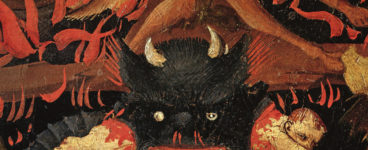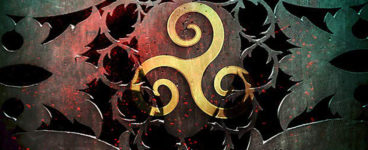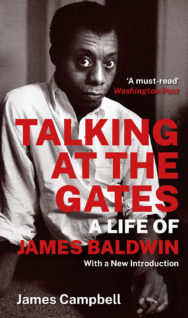‘He had the most extraordinary eyes I’ve ever seen. When he had completed his instant X-ray of my brains, lungs, liver, heart, bowels, and spinal column (while I said usefully, “Emile sent me”) he smiled and said, “Come in,” and opened the door.’
Writer and critic James Campbell knew the James Baldwin for the last years of Baldwin’s life, and their friendship fed into Campbell’s biography of the great writer, originally published 30 years ago. Talking at the Gates: A Life of James Baldwin is being republished this month with a new introduction, and is still vital reading for anyone interested in the life and work of one of the 20th century’s greatest writers.
Extract taken from Talking at the Gates: A Life of James Baldwin
By James Campbell
Published by Polygon
The boom years of the 1920s—the era of the consumer revolution, of mass production and the assembly line, of great building in New York and fortunes on the stock market—scarcely touched America’s 16 million black citizens. Moreover, a population the size of Canada’s could look in vain to find itself represented in national literature, art, drama, or the cinema, unless to serve as nannies, doormen, or grinning entertainers (“Black girl, stretch / Your mouth so wide”). Out of this determined anonymity in the 1920s emerged an abstraction called the New Negro, who embodied the aspirations of the rising generation. Simultaneously, but not coincidentally, the cultural phenomenon known as the Harlem Renaissance came into being. Among its leading lights were James Weldon Johnson, Langston Hughes, Countee Cullen, Jean Toomer, and Claude McKay. Encouraged in some cases by white editors and patrons, such as Carl van Vechten and Joel and Amy Spingarn, they and others produced a stream of novels, poems, plays, and essays reflecting the experience of the modern American black.
The main activity of the Harlem Renaissance took place in the years immediately before and after James Baldwin’s birth. In 1924 Alain Locke was preparing an anthology to be published under the title The New Negro. Yet the mass of blacks in Harlem were as little affected by the so-called renaissance in their midst as they were by the “boom” they might hear in the downtown distance. “The ordinary Negroes hadn’t heard of the Harlem Renaissance,” Langston Hughes remarked in his autobiography The Big Sea (1945). “And if they had, it hadn’t raised their wages any.”
The Baldwin family certainly had at once more basic and more lofty concerns—food and worship—and even when he came to artistic conscious-ness in the early 1940s James Baldwin showed scant interest in the cultural movement that had flourished in the neighborhood during his childhood.
The puritanical regime which his father exercised under his roof was one reason for Baldwin’s lack of interest in the black renaissance; but what is more important is that from the moment he first knew he was going to be a writer—a writer or nothing at all—Baldwin set his course for the mainstream. The conditions were, to say the least, unfavorable. When he began to write in earnest in the mid-1940s, only one black writer in the history of America, Richard Wright, had been treated to national acclaim. But for Baldwin the important thing was to become an artist; to make oneself into a “Negro writer” was to accept the patronage of the literary world, and one’s place in the second rank.
While his subject matter, even in his juvenilia, was more often than not black, like Wright and a majority of American writers of the time he looked to Europe for formal models. The evidence contained in “Black Girl Shouting”* apart, he left behind scarcely a hint that he even held an opinion about the prime movers of the Harlem Renaissance: Toomer, Johnson, and McKay he never mentioned in print; Hughes was to be the subject of a scathing review in the New York Times in 1959. As for Cullen, who had been a teacher at Frederick Douglass Junior High School, Baldwin passed no opinion on his poems and was later unable to recall which subjects he had taught.
The first artist to exert a strong personal influence on him was not a writer at all, but a painter. By the time Baldwin met him, Beauford Delaney was already a respected and admired figure among the artistic community of Greenwich Village. Henry Miller wrote a long essay extol-ling the painter, “The Amazing and Invariable Beauford Delaney” (1945), which speaks—like all accounts by those who knew him—of Delaney’s gentleness, kindness, and ready friendship: “Beauford retains the green vision of a world whose order and beauty, though divine, are within the conception of man. The more men murder one another, bugger one another, corrupt one another, the greater his vision becomes.”
Born into a poor black family in Tennessee in 1901, Delaney had come north in the 1920s. To Baldwin, who met him in 1940, five years before Miller paid homage, he was to prove a teacher; in the young would-be writer, more than twenty years his junior, Delaney found a willing pupil and a friend for life. Addressing a group of women prisoners at Riker’s Island, New York, over three and a half decades later, Baldwin said: “The most important person in my life was and is . . . Beauford Delaney.”
Recalling the day when he first knocked on Delaney’s door in Greenwich Village, Baldwin wrote:
He had the most extraordinary eyes I’ve ever seen. When he had completed his instant X-ray of my brains, lungs, liver, heart, bowels, and spinal column (while I said usefully, “Emile sent me”) he smiled and said, “Come in,” and opened the door.
He opened the door all right.
Cullen apart, Delaney was the first genuine artist Baldwin had met. His attitude toward the Harlem Renaissance poet was one of schoolboy to schoolmaster, whereas he found Delaney warm and friendly, with a gift for instruction by example. In his studio at 181 Greene Street, Baldwin heard recordings of Ella Fitzgerald, Fats Waller, Bessie Smith—all forbidden at home—and listened to the older man talk about painting. “I learned about light . . . he is seeing all the time; and the reality of his seeing caused me to begin to see.”
Delaney was important not only for his aesthetic teaching, but for the precedent Baldwin found in his way of living. Delaney was neither famous nor rich; yet he was incontrovertibly an artist. And although he was a black artist, his work was not complicated—or simplified—by matters of protest. He tried above all to do his duty as a painter: to see clearly and to put down what he saw, to bear witness.
In the same year that Baldwin met Delaney, an important event took place in American letters: the publication of Native Son by Richard Wright, perhaps the first novel by a black American to be regarded in the literary world as a work of major significance. These two encounters—with Delaney in person, with Wright through his novel—together form the most profound influence on Baldwin in his teens. His career at the Magpie had already helped him chart a route to his proper subject: his people, seen through the lens of his own self. Now Beauford Delaney opened the door on a way of seeing. And Richard Wright showed that a black writer need have no fear of competing with whites on equal terms.
These meetings also had their effect on Baldwin the preacher. The sacred, it turned out, was not the only domain to scrutinize in search of the “everlasting life”; looked at another way, perhaps the Holy Ghost might be identified here on earth, among human beings, in works of art. (Baldwin had yet not reached the stage where salvation would be pursued via the profane.) Beauford Delaney taught him that art was a way of celebrating the material world, of transcending it and returning to it some-thing of itself in coherent, meaningful form.
* Black Girl Shouting
(first published in James Baldwin’s school magazine, The Magpie)
Stomp my feet
An’ clap my han’s
Angels comin’
To dese far Ian’s.
Cut my lover
Off dat tree!
Angels comin’
To set me free.
Glory, glory,
To de Lamb
Blessed Jesus
Where’s my man?
Black girl, whirl
Your torn, red dress
Black girl, hide
Your bitterness.
Black girl, stretch
Your mouth so wide.
None will guess
The way he died
Turned your heart
To quivering mud
While your lover’s
Soft, red blood
Stained the scowling
Outraged tree.
Angels come
To cut him free!
Talking at the Gates: A Life of James Baldwin by James Campbell is published by Polygon, priced £14.99.
ALSO IN THIS ISSUE

 The Satanic in Science Fiction and Fantasy
The Satanic in Science Fiction and Fantasy
‘He is synonymous with bloody sacrifice, scheming, false idols, lies, cunning tests, death and bruta …

 The Book According to… Craig Russell
The Book According to… Craig Russell
‘I think every writer explores the complexities, paradoxes and contradictions of their own cultural …













